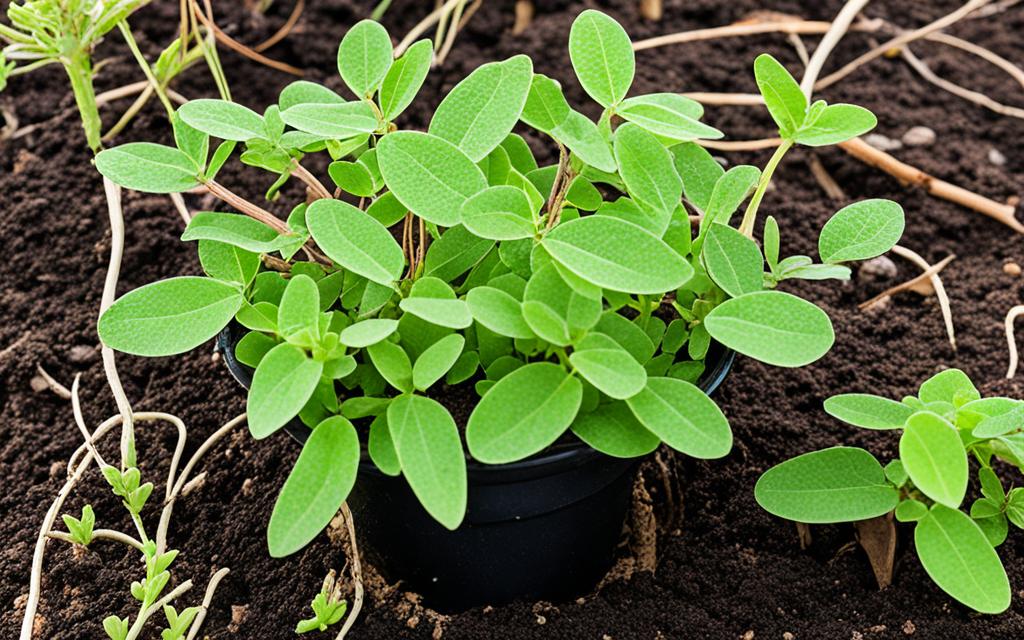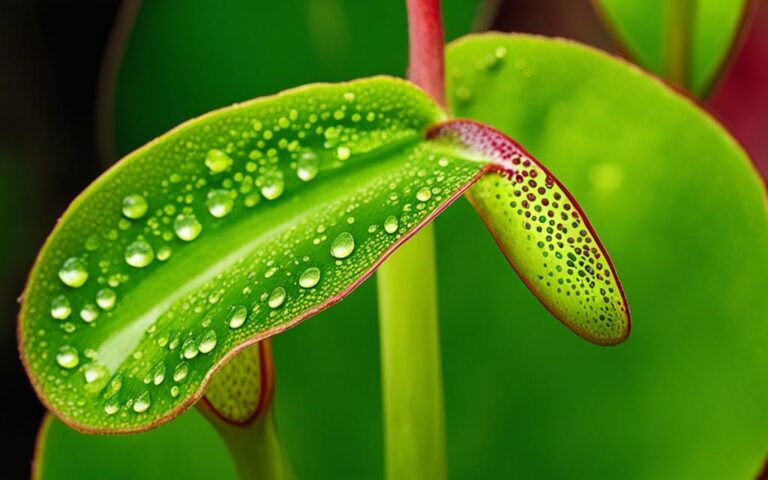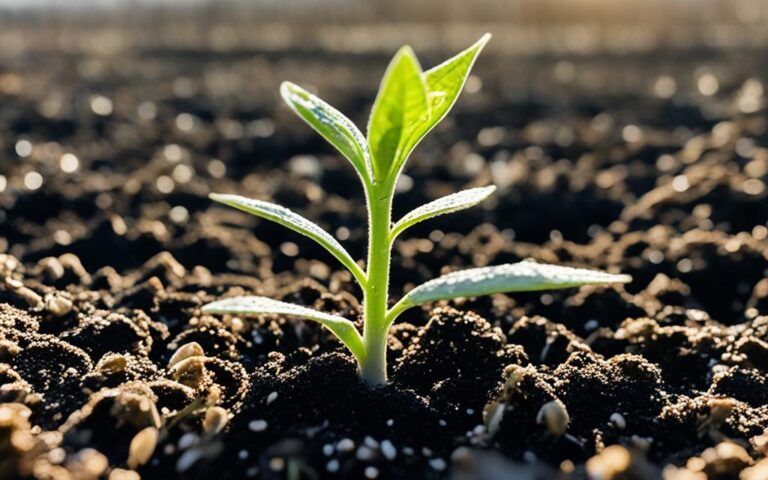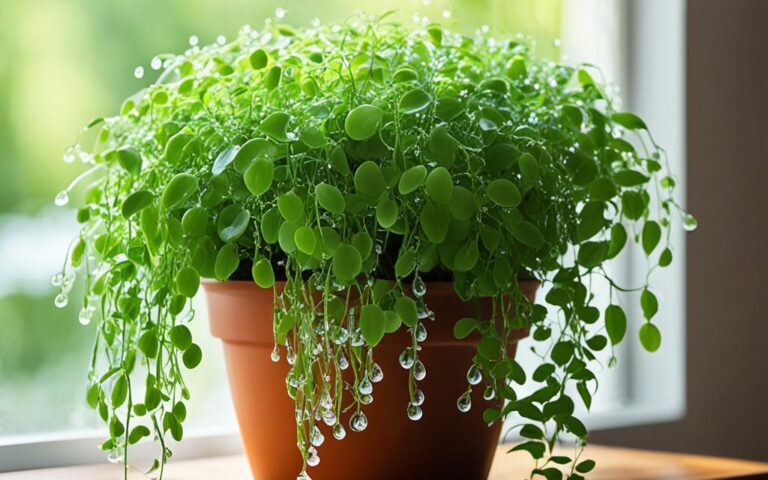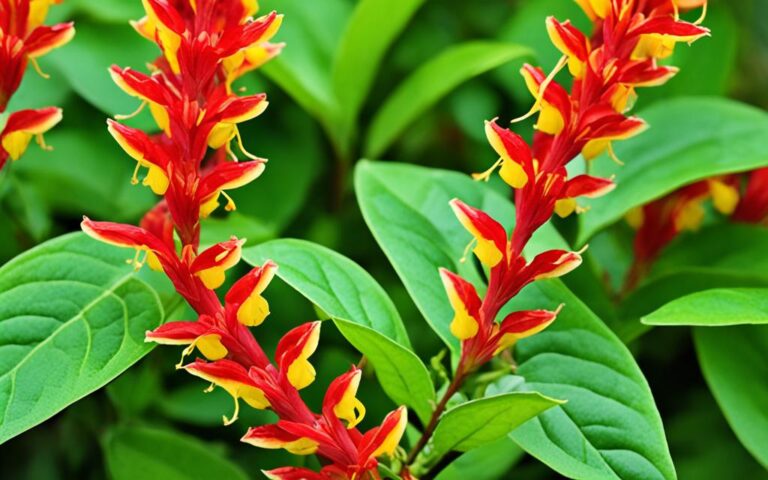Licorice Plant: Growing and Uses of Sweet Root
Did you know the tall leguminous shrub with violet flowers is called Glycyrrhiza glabra or Licorice? It was once wild in Southern Europe, North Africa, and Western Asia. Now, it’s grown in the Middle East for its roots. These roots have a sweet sap used in sweets and tobacco.
This plant is in the legume family and helps the soil by fixing nitrogen. Its flowers are loved by bees, making it great for gardens. Licorice is amazing for health and cooking, showing how special it is.
Key Takeaways
- Glycyrrhiza glabra, or licorice, is a tall leguminous shrub with violet flowers that was once found growing wild in Southern Europe, North Africa, and Western Asia.
- The plant is now extensively cultivated in the Middle East for its prized roots, which contain a sweet, aromatic sap used in confectionery and the tobacco industry.
- Licorice is a member of the legume family, hosting nitrogen-fixing bacteria in its root nodules and enriching the surrounding soil.
- The plant’s gorgeous flowers attract bees, making it a valuable addition to any garden.
- Licorice has a wide range of medicinal and culinary uses, making it a versatile and fascinating plant.
Introduction to Licorice Plant
The licorice plant, known as Glycyrrhiza glabra, is a perennial shrub. It is loved for its sweet roots. It comes from parts of Europe and Asia but is grown all over the world. It’s known for its violet flowers and helps fix nitrogen in the soil.
Interesting Facts and Popularity
Licorice has been used for thousands of years. People value it for its health benefits and use it in food, sweets, and medicine. Studies now show it can protect the heart and fight bacteria.
Common Species and Varieties
- Glycyrrhiza glabra: This is the most common type of licorice, known for its sweet taste.
- Glycyrrhiza uralensis: Found mainly in China, it’s similar to the original licorice plant and is widely used.
- Glycyrrhiza yunnanensis: Another type from China, its roots are often linked with traditional licorice.
These licorice types and their unique traits make the plant popular worldwide.
“Licorice is a perennial leguminous shrub that has gained popularity for its sweet, aromatic roots.”
Anatomy and Description
The licorice plant, known as Glycyrrhiza glabra, is a tall, leguminous shrub. It can grow up to 90cm (3ft) tall. This perennial plant is famous for its violet flowers that move with the wind.
Leaves, Stems, and Flowers
The licorice plant has lush, green leaves that are pinnately compound. These leaves have leaflets in pairs along the stem. The stems are sturdy and woody, supporting the plant. The plant’s flowers are a beautiful violet color, adding beauty to the licorice.
Special Features of the Licorice Plant
The licorice plant can fix nitrogen in the soil, enriching the area around it. Its deep and wide root system can go up to 26 feet long. This shows how adaptable and resilient the plant is.
“The term ‘liquorice’ has origins dating back to late Latin and Greek, meaning ‘sweet root.'”
Ideal Growing Conditions
Licorice plants love warm, humid places. They do best in full sun but can handle some shade. They need deep, rich soil that drains well and is a bit alkaline, with a pH of 6.0 to 8.0.
Light, Temperature, and Humidity Requirements
Licorice plants are perfect for USDA zones 9-11, where they live as perennials. In colder areas, they can be grown as annuals or kept indoors over winter. They need at least 6 hours of direct sunlight a day.
They can handle temperatures as low as 25°F to 30°F. But, they’re not frost-hardy, so protect them from cold snaps.
Soil Needs and pH Levels
Licorice plants do well in deep, rich soil that drains well. The soil should be a bit alkaline, between 6.0 and 8.0. Avoid soil that drains poorly to prevent root rot.
They can survive drought but grow better with regular watering. Water them every two to three weeks in the summer.
Watering Needs for Licorice Plants
Water licorice plants well when they’re young. As they get used to their environment, they can handle drought better. But, they still need water during dry times.
Too much water can cause powdery mildew. So, make sure the soil drains well and water carefully.
By giving licorice plants the right conditions, gardeners can help them grow well. This leads to a lot of this tasty and versatile root.
Propagation Methods for Licorice
Licorice plants can be grown in several ways, making it easy to share or expand your collection. You can grow them from seeds or use cuttings and division. Knowing the best methods ensures success.
Growing Licorice from Seed
Licorice seeds need light to start growing and should be planted in warm soil in late spring. The seeds typically take 4-6 weeks to sprout, and it may take 1-2 years for new plants to grow fully. Growing from seed is rewarding but takes time and careful attention.
Licorice Plant Cuttings
- Licorice plants can be grown from cuttings taken from healthy, mature plants.
- These cuttings need consistent moisture and soil that drains well to root well. Avoid overwatering or poor drainage to prevent rot.
- Use sterilized, sharp tools for taking cuttings to avoid harming the stem and keep the plant healthy.
Licorice Plant Division
- Divide licorice plants in the spring or fall when they are mature and have growth buds.
- After dividing, new growth starts within 4-6 weeks, and plants may need gentle care and fresh soil.
- Keep divided licorice plants in bright, indirect sunlight to help them grow and settle well.
Learning these propagation methods helps gardeners grow and share licorice plants. This ensures they stay in gardens and landscapes.
| Propagation Method | Time to Establish | Key Considerations |
|---|---|---|
| Seed | 1-2 years | Requires light to germinate, patience during seedling stage |
| Cuttings | 4-6 weeks | Consistent moisture, well-draining soil, sterilized tools |
| Division | 4-6 weeks | Divide during spring or fall, provide gentle care after division |
Licorice Plant Care and Maintenance
Proper care and maintenance are key for healthy licorice plants. Whether you grow them for medicine, cooking, or decoration, knowing the right techniques is crucial.
Pruning and Training Techniques
Licorice plants do well with yearly pruning or the “chop-and-drop” method. Cutting the top parts back to the ground level makes them bushy and prevents powdery mildew. Always use clean, sharp tools and cut just above the leaf nodes when pruning.
Common Pests, Diseases, and Solutions
Spider mites and slugs can bother licorice plants. Use natural predators like ladybugs or organic pest control to keep them healthy. Also, watch for fungal diseases like powdery mildew and treat them quickly to keep your plants in good shape.
Fertilizers for Macro and Micronutrients
Licorice plants need balanced fertilizers with macro and micronutrients. Choose fertilizers made for licorice plants or those with a 10-10-10 or 12-12-12 ratio. Use these during the growing season, as directed by the manufacturer.
Knowing how to care for licorice plants ensures they grow well. This way, you get to enjoy their beauty and harvests.
Health and Medicinal Benefits
The licorice plant, or Glycyrrhiza glabra, has been used for health for a long time. Its roots have compounds that help with health. These compounds are known for fighting inflammation, germs, and stress.
They help with many health issues like stomach problems, breathing issues, and women’s health. They also help the body deal with stress and tiredness.
A key compound in licorice is glycyrrhizin. It’s much sweeter than sugar. This helps reduce fat, heal stomach ulcers, and fight infections. Studies show it can even help prevent and treat some cancers.
It also fights bacteria and viruses, like Staphylococcus, Streptococcus, and Candida albicans. It can also stop viruses like HSV-1, HRSV, and HIV. Plus, it helps prevent and treat stomach ulcers by making more mucus and reducing stomach acid.
| Compound | Health Benefits |
|---|---|
| Glycyrrhizin |
|
| Licorice Root Extract |
|
But, licorice root can also have bad effects. It can cause heart rhythm problems, high blood pressure, and harm to babies if taken too much, especially when pregnant. It can also change how some medicines work. So, talk to a doctor before using it for health.
“Licorice root is a versatile medicinal plant with a wide range of health benefits, but it should be used with caution and under the guidance of a healthcare provider.”
Licorice Plant in Food and Culinary Uses
The licorice plant (Glycyrrhiza glabra) is a versatile addition to many dishes. Its sweet roots add a unique flavor to foods and drinks. From teas and syrups to baked goods, licorice root makes a special touch that boosts the flavor.
Licorice plant is often used as a flavoring in the kitchen. The dried roots add a subtle sweetness to recipes. Sugars and honeys flavored with licorice are great for desserts and hot drinks.
But licorice plant isn’t just for sweets. It can also be used in savory dishes. Sliced or grated roots can be added to stir-fries, soups, and stews for a unique taste. This plant fits well into many dishes, making them stand out.
- Licorice root can be chewed directly as a flavorful snack.
- The root can be used to infuse teas, syrups, and baked goods with its distinctive taste.
- Licorice can be incorporated into savory dishes like stir-fries, soups, and stews to add a unique flavor profile.
- Licorice-infused sugars and honeys are popular for sweetening desserts and beverages.
The licorice plant has a captivating aroma and a sweet, anise-like flavor. It’s great for both sweet and savory dishes. This plant makes food memorable with its versatility.
“Licorice is a versatile and flavorful ingredient that can elevate a wide range of culinary creations, from sweet to savory.”
Harvesting Licorice Root
Harvesting licorice root is key in its cultivation. It’s the main part used for medicine and cooking. The best time to pick it is when the plants are fully grown, usually after 3-4 years.
When and How to Harvest
Licorice roots are best picked in the fall, around September. This ensures they are fully grown and full of good stuff. To do this, dig carefully around the plant and pull out the roots. Make sure to leave the deep taproot so the plant can keep growing.
Processing and Drying Licorice Root
After harvesting, clean and process the licorice roots. Wash them to get rid of dirt, then dry them out. You can air-dry or use a dehydrator to dry them. Drying is important to keep their flavor and health benefits.
Once dried, you can use the licorice roots in many ways. You can make teas, tinctures, or add them to food.
“Licorice root has been used for centuries in traditional medicine. It’s known for helping with digestion and reducing inflammation.”
Licorice Products and Preparations
Licorice comes from the Glycyrrhiza glabra plant and has been used for centuries. It’s not just for its sweet taste but also for its health benefits. The root can be made into many products that are good for us.
Dried licorice sticks or powder are common forms. You can chew them or add them to teas and syrups. Licorice-infused honeys and lozenges soothe the throat and help with digestion.
Now, licorice extracts and supplements are more popular. They add flavor and improve mouthfeel in foods and medicines. MagnaSweet, made from licorice, is great for many products.
Pure licorice is also used in cosmetics and personal care items. It helps with skin issues, hydrates, and brightens. Mafco makes many licorice-based products for these uses.
| Licorice Product | Description | Applications |
|---|---|---|
| Dried Licorice Sticks/Powder | Dehydrated licorice root with a chewy, sweet texture | Snacks, tea infusions, decoctions, syrups |
| Licorice Extracts and Supplements | Concentrated forms of licorice root, such as MagnaSweet | Flavor enhancement, bitterness masking, mouthfeel improvement in foods, beverages, pharmaceuticals, and personal care products |
| Licorice-Derived Cosmetic Ingredients | Pure licorice derivatives like Monoammonium Glycyrrhizinate, Dipotassium Glycyrrhizinate, Glabridin | Skin care, hair care, makeup, and other personal care formulations |
Licorice is a versatile plant with many uses. It benefits both food lovers and those focused on wellness.
Cultural Significance and History
The licorice plant, known as Glycyrrhiza glabra, has a rich history. It’s been important in many cultures for centuries. People have used it as a medicine and flavoring in Europe and Asia.
The name “licorice” comes from Greek words. “Glykys” means “sweet” and “riza” means “root.” It was first used in ancient times by Assyrians, Egyptians, Chinese, and Indians. They used it for medicine.
- Theophrastus, a Greek philosopher, was one of the first to talk about licorice in Europe. He called it the “Scythian” root.
- Pliny the Elder, a Roman writer, said licorice was good for many health issues. He recommended it for asthma, throat problems, and even infertility.
- In the Middle Ages, monks in monasteries knew a lot about plants. People like Hildegard von Bingen and Abu Mohammed Abdallah Ben Ahmed Dhialeddin Ibn Albaithar studied licorice’s health benefits.
Licorice is more than just a medicine. In the Netherlands, people eat the most licorice in the world. Sweden even has a festival about licorice, the Lakritsfestivalen, since 2009.
“Licorice consumption per capita is highest in the Netherlands.”
Licorice is popular in many areas, like the tobacco industry. It’s often found in pipe and plug tobacco. Its long history and cultural importance make it a key part of our heritage.
Sustainable and Ethical Cultivation
The need for sustainable licorice cultivation and ethical licorice growing is growing. Licorice populations are stable, but we must take care of them. This means using crop rotation, intercropping, and selective harvesting to keep licorice plants healthy and diverse.
Keeping licorice plant conservation in mind is crucial. Many medicinal and aromatic plants, like licorice, are taken from the wild. If we don’t manage them well, they could disappear.
Now, we’re seeing more focus on ethical and sustainable licorice farming. Organic licorice root production has gone up by 20% in five years. People want products made from licorice that is grown right, and they’re happy with them, with a satisfaction rate of 90%.
Using sustainable farming methods has many benefits. For example, it uses 40% less water for each harvest. And, organic licorice products like 5th Chakra Tea have seen a 35% increase in the market. This shows how important it is to take care of licorice and other plants in a responsible way.
| Metric | Increase/Growth |
|---|---|
| Organic Licorice Root Production | 20% in the past 5 years |
| Demand for Ethically Sourced Licorice Extract | 15% annually |
| Consumer Satisfaction with Sustainable Licorice Products | 90% |
| Reduction in Water Usage per Licorice Harvest | 40% |
| Market Share Growth for Organic Licorice-based 5th Chakra Tea | 35% |
By choosing sustainable and ethical ways to grow licorice, we can keep this plant around for a long time. We can also meet the demand for licorice products. With careful management and new farming methods, the licorice industry can lead the way in being sustainable and ethical.
Licorice Plant Varieties and Cultivars
The licorice plant, Glycyrrhiza glabra, has many species and cultivars. Each one has its own special traits. From the sweet Spanish licorice (Glycyrrhiza glabra) to the strong Chinese licorice (Glycyrrhiza uralensis) and the tasty Xinjiang licorice (Glycyrrhiza inflata), there’s a wide range of choices for cooking and health.
These licorice plants differ in root size, taste, and how well they grow. Some do better in cold weather, while others like it warmer. Knowing about each type helps gardeners and producers pick the best one for their needs.
| Licorice Plant Variety | Key Characteristics | Optimal Growing Conditions |
|---|---|---|
| Glycyrrhiza glabra (Spanish Licorice) | Sweeter flavor, medium-sized roots | Warm, Mediterranean climates |
| Glycyrrhiza uralensis (Chinese Licorice) | Robust growth, larger roots, more intense flavor | Temperate, continental climates |
| Glycyrrhiza inflata (Xinjiang Licorice) | Distinctive aroma, adaptable to various conditions | Diverse, including arid and semi-arid regions |
If you’re into gardening, cooking, or health, exploring licorice plant varieties is exciting. You can find everything from the mild taste of Spanish licorice to the rich flavors of Chinese and Xinjiang licorice. This family of plants is a treasure trove of flavors and benefits.
Conclusion
The licorice plant, known as Glycyrrhiza glabra, is a true marvel with a long history and many uses. Its sweet roots and ability to fix nitrogen make it great for cooking and medicine. Gardeners and herb lovers can grow licorice by learning how to care for it and use it wisely.
Researchers and users are still discovering the licorice plant’s benefits. In places like Uzbekistan and Karakalpakstan, it helps the economy, society, and environment. It grows well in tough conditions and can even help clean polluted soil. Plus, its medicine could fight off viruses, making it very important for health.
In the end, the licorice plant is a treasure with a long history and many uses. It’s perfect for cooking, medicine, and helping the planet. By exploring its potential, we can enjoy tasty foods, heal naturally, and solve big environmental problems.
